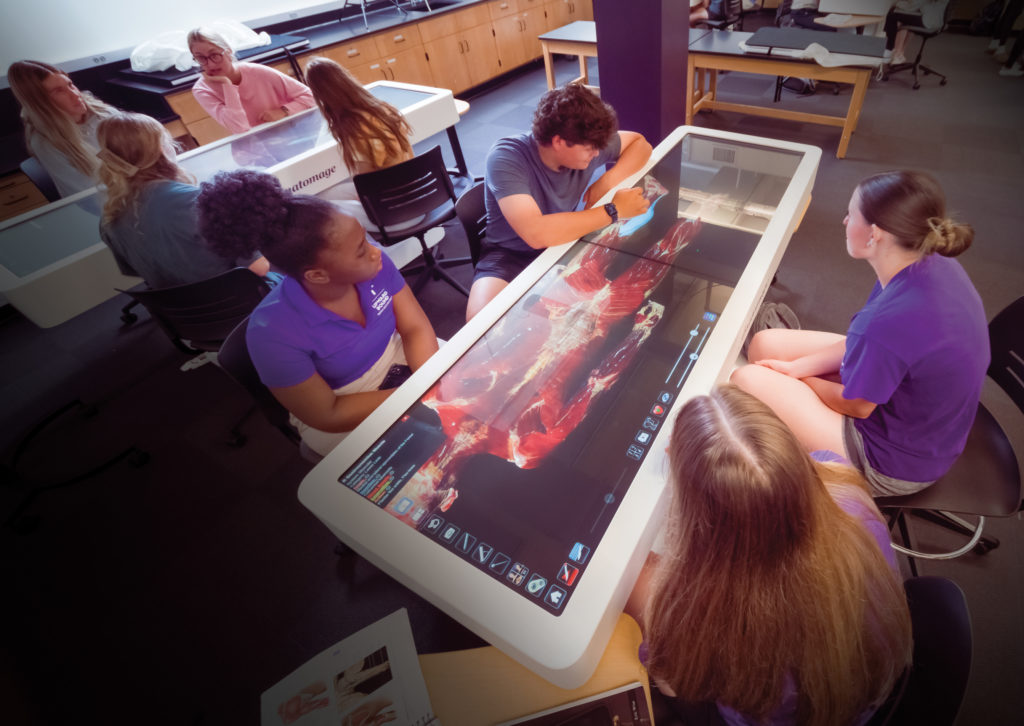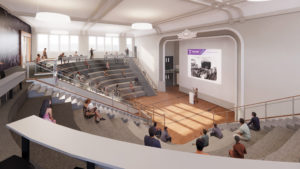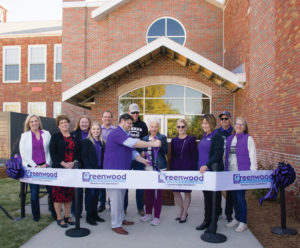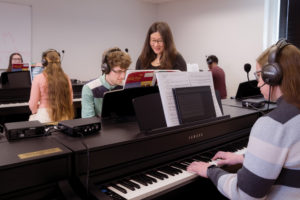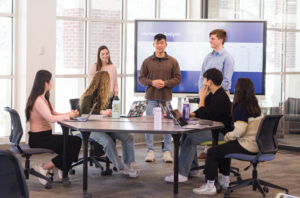By thinking long term, Truman is in a position to meet the needs and interests of today’s students while helping prepare them for the careers of tomorrow.
One hundred years ago, the Kirk Building was the site of a pivotal moment in the University’s history. Just a day after fire ravaged the original Baldwin Hall and library in 1924, faculty, students and members of the community came together to determine the fate of the school. With the remnants of the burned structures still scattered within eyesight of their meeting, those in attendance vowed to move forward and do whatever it took to keep the University alive. Business owners made space in their stores, church leaders offered their sanctuaries as lecture halls and A.T. Still University provided campus resources. The can-do spirit of the moment, combined with an outpouring of community generosity, not only saved the University, it started a path to greatness that remains today.
Fittingly, Kirk Building is again a harbinger of what should be another successful 100 years. Truman is in the process of a $21 million renovation that will breathe new life into the historic structure and make it a hub for student services, as well as a vital resource center available to the local community. The Kirk project is one of many signs that Truman will control its own destiny, no matter the situation.
Higher education is in the midst of an industry-wide shift. According to the Pew Research Center, in 2022 the total number of 18- to 24-year-olds enrolled in college was down by approximately 1.2 million from its peak in 2011. While the pandemic exacerbated the issue, it has been a nationwide trend for years. How higher education arrived at this moment in time, and what the future may hold, could be examined at length. For Truman, the solution lies within.
“Throughout our history, applying the wisdom of our first president, Joseph Baldwin, to ‘find right, choose right, do right, enjoy right’ in contemporary and impactful ways has ensured that Truman rises to successfully meet every challenge,” said University President Sue Thomas. “Today is no different.”
The University’s track record of adaptability and innovation goes back to its roots. After starting as a normal school exclusively to train future educators, the institution evolved to feature a number of undergraduate and graduate programs. With the mission change nearly 40 years ago, the University refocused its academic structure, letting go of programs that did not fully serve the student body, while at the same time investing in those that would be in-demand for years to come.
“Our commitment to continuous improvement and adaptability can be found in the introduction of our current strategic plan – ‘through a renewed liberal arts and sciences curriculum that is deliberately built for the modern world, we are dedicated to each of our student’s individual pursuits and ensure their engagement in learning and discovering their personal and professional purpose by providing intentional curricular and co-curricular opportunities which are applicable to real-world challenges,’” Thomas said.
Nowhere is that point more evident than in Truman’s newly established Greenwood Interprofessional Autism Center (page 2). The University purchased the decommissioned elementary school in 1999, primarily because of its proximity to campus, and it was used as storage for several years. Starting in 2015, Truman embarked on a mission to convert the facility into a center that could serve individuals and their families affected by autism and other neurodevelopmental disorders. After nearly a decade of planning, making the case for support to state, federal and philanthropic leaders, and after nearly $9.4 million in renovations, a project that once seemed incomprehensible became a reality. Not only does the Greenwood Interprofessional Autism Center provide a service to the community, it opens the door to hands-on learning experiences in an emerging career field.
It is easy to measure success in brick-and-mortar achievements, but the Kirk and Greenwood projects are far from the only recent hallmarks of innovation at Truman. New academic programs are constantly being added to meet both the interests of today’s students and the demands of tomorrow’s workforce.
Continued expansion in data science has positioned the University as a leading institution in the field in Missouri. Simply put, data science focuses on making meaning from information. Program participants learn how to collect and analyze data, as well as gain knowledge of techniques to effectively communicate insights that can be used to solve problems through informed decision making. Nearly every industry utilizes data to some extent, from businesses trying to effectively manage inventory and purchasing decisions to streaming platforms suggesting what to watch next.
“Everyone has tons of data and they don’t know what to do with it,” said Scott Alberts, chair of the Department of Statistics and Data Science. “This program focuses on making meaning from information, including use of tools such as distributed computing and machine learning. Those skills can be used in a wide array of career fields, making this a versatile and valuable degree.”
Truman began cultivating a data science program in 2018 with the addition of a graduate certificate program that eventually led to a master’s degree option. Earlier this year, a bachelor of science option was added, putting Truman among the first institutions in Missouri to offer an undergraduate degree in the discipline. Furthermore, Truman has worked with K-12 and community college partners to create a data science pipeline that prepares students from a wide age range to potentially pursue data science degrees and careers.
In some instances, opportunities can arise from the infrastructure of well-established programs. Building on the University’s rich history with music, Truman now offers bachelor’s degree options in music business and music therapy.
“A degree in music provides students with many options, and that is something we want to offer students as they plan for their future,” said Steve Parsons, dean of the School of Arts and Letters. “These new programs allow students to channel their acquired musical skills into a number of exciting career possibilities.”
The business option provides aspiring music business professionals, entrepreneurs and artists with the knowledge and skills they need to succeed in the industry. Its broad collection of electives enables students to personalize their coursework to fit their specific professional aspirations.
Students who want to combine their interest in music with a desire to help others can take the music therapy option. Along with rigorous training to develop musicianship and performance skills, this program includes courses in biology, nursing, sociology and anthropology.
In a sense, there is a free-market aspect as to what degrees may one day be available, and innovative institutions have to be cognizant of the societal winds of change. A perfect example of that is the cannabis and natural medicinals major. In the wake of Missouri residents voting to ease cannabis laws, a new industry was created, with some projections forecasting the state market to generate more than $1.3 billion per year. This interdisciplinary degree integrates the science behind cannabis and medicinal plants, as well as the business and regulatory aspects of medicinal plants, and the social and cultural aspects of medicinal plant use.
“This is a booming industry in our state and it is vital to have qualified, well-trained individuals to fill the workforce needs. We want Truman graduates to be leaders in this industry,” said Tim Walston, dean of the School of Science and Mathematics. “A lot of thought went into creating this major, and we were able to put it together with many of the faculty and facility resources we already had in place. Our program is good for the school, good for the state and good for our graduates.”
There is no limit on paths to success. Whether the goal is solving a world problem or developing a product and taking it to scale, a liberal arts institution is the ideal breeding ground for creative solutions. A recent campus addition supporting those endeavors is the Doug and Diane Villhard Innovation Lab located in Pickler Memorial Library. This newly renovated space features collaborative writing surfaces and networked computers with creative software. A design lab offers hands-on experiences in problem solving and critical thinking, while the multimedia studio provides the ability to produce podcasts, along with video conferencing equipment to connect and collaborate with remote partners.
“The Villhards are big proponents of entrepreneurship. They wanted to create an environment that is conducive to developing big ideas,” said Charles Hunsaker, executive director for University advancement. “Innovation can come from anywhere, not just students who may want to start a business. They were excited about the lab being located in the library so students from any discipline would feel welcome to use the space and explore any topic that spoke to them.”
The importance of hands-on opportunities cannot be overstated, and Truman has established some that students can’t find just anywhere. Magruder Hall is now home to a virtual anatomy lab featuring six 84-inch, digital-screen tables that allow for life-size displays and interactive exploration.
“This cutting-edge facility not only provides a dynamic learning environment for our current students, it also attracts aspiring scholars by showcasing Truman’s commitment to providing high-quality educational experiences,” said Stephen Hudman, associate dean of the School of Science and Mathematics. “Beyond the study of humans, the tables in the virtual anatomy lab also provide models of other systems that are useful in the study of comparative anatomy.”
The tables include 3D medical-school-level anatomy content up to 0.2 mm. Among other features, students are able to participate in interactive dissections and virtual arthroscopy, as well as view blood-flow simulation and fly-through simulations in the respiratory tract, gastrointestinal tract and chambers of the heart. The high-resolution images afford users an in-depth view of major structures in the body, such as the heart, lungs, abdomen and pelvis, that might be more difficult to see through previous instruction methods.
The coming academic year will also give Truman students access to the University’s first “supercomputer” (page 4-5). Through a recent National Science Foundation award of nearly $700,000, Truman is one of four schools in Missouri partnering to develop a high-performance computer (HPC).
“With computational resources becoming nearly ubiquitous in both academic research and a wide range of career sectors, we think it is important to provide students with the opportunity to work with HPCs as part of their education,” said Colin DeGraf, assistant professor of physics and co-principal investigator for the NSF grant. “The experience and skills they can gain from this should help them with their next step after graduation – whether going to graduate school or entering the job market – and also make them more productive in any computational field they might enter.”
Students and researchers who benefit from the HPC could come from almost any scientific discipline. In their NSF application, DeGraf and his fellow investigators included cases ranging from astrophysical simulations, computational chemistry, data science, cybersecurity and genetics.
Almost everything commonplace today was at one time a novelty. The telephone started as bulky box connected to a community switchboard, and a television was once found only in the living rooms of the select few who could afford it. Now people can use the former to watch the latter from almost anywhere. That same device also provides access to an endless supply of music, books, messages, games, news, apps and — for anyone still inclined to make them — phone calls. Those improvements came to fruition because visionary individuals saw what else was possible. Progress should be embraced, not feared. The subject matters traditionally associated with a well-rounded education — math, science, arts, humanities — will always have a home at a liberal arts institution. Whatever additional programs may arise, they do not come at the expense of any core disciplines, but rather are possible because they are built on the shoulders of those that came before it. When computer science programs were developed in the mid-20th century, there were probably many skeptics. Now that discipline is a must-have component of any reputable institution.
Innovative is not synonymous with intricate. One reason Truman can accomplish innovative achievements is because the core of the school’s philosophy is simple: put students in a position to be successful after they graduate. That is easier said than done, and it speaks to the quality of the University as a whole that Truman makes it happen. Faculty members make genuine connections with students and care about their best interests. Administrative leadership has put the school in a solid financial situation that affords it the opportunity to be proactive. The long-term success of the University belongs not to one person or era, but rather to every student, employee, alumni and friend who has done whatever it takes to continue moving forward, just like those people at the Kirk Building meeting 100 years ago. Truman’s track record of innovation has set it apart for decades, and it will propel the University forward for decades to come.

